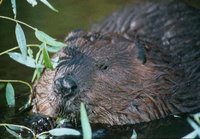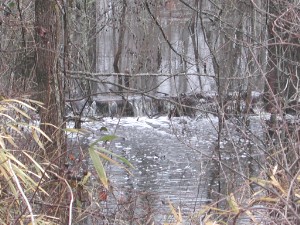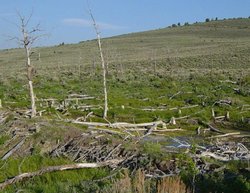Beaver
|
|
| Beaver | ||||||||||||
|---|---|---|---|---|---|---|---|---|---|---|---|---|
 American Beaver | ||||||||||||
| Scientific classification | ||||||||||||
| ||||||||||||
| Species | ||||||||||||
Beavers are semi-aquatic rodents native to North America and Europe. They are the only members of the family Castoridae, which contains a single genus, Castor. Genetic research has shown the European and North American beaver populations to be distinct species and that hybridization is unlikely.
Beavers are best known for their natural trait of building dams in rivers, and building lodges in the eventual artificial pond. They are the second largest group of rodents, after the capybara, with adult specimens weighing over 25kg not being uncommon.
| Contents [hide] |
Species
The European Beaver (Castor fiber) was hunted almost to extinction in Europe, both for fur, and for castoreum, a secretion of its scent gland believed to have medicinal properties. However the beaver is now being re-introduced throughout Europe. Several thousands live on the Elbe, the Rhone and in parts of Scandinavia. They have been reintroduced in Bavaria and The Netherlands and are tending to spread to new locations. The beaver became extinct in Great Britain in the sixteenth century, but there are proposals, and a great deal of interest, in reintroducing the European Beaver to Scotland.
The American Beaver (C. canadensis) is the national animal of Canada; in fact, it is depicted on the Canadian five-cent piece and was on the first Canadian postage stamp, the Three Penny Beaver. However, in several areas of that country, it is considered a pest. It is also the state animal of Oregon, the state mammal of New York (after the historical emblem of New Netherland) and the mascot of Oregon State University. It is also a common school emblem for engineering schools, including the California Institute of Technology and the Massachusetts Institute of Technology.
Dams
The dams are created both as a protection against predators (bear is the only natural predator) and to provide easy access to food during winter. It is the sound of water in motion that stimulates the beavers to build, and if for example a pipe is placed under the dam to drain it the beavers will not do anything about it. However they repair any damage to the dam and build it higher as long as the sound is there. Conversely, beavers will attempt to build dams in response to recordings of water flowing even in the absence of water.
The ponds created by well-maintained dams help isolate the beavers' home, their lodge, also created from severed branches and other natural sources. The lodge has an underwater entrance to make entry nearly impossible for any other animal.
Destroying a beaver dam without removing the beavers takes a lot of effort.
Fur Trade
Beaver pelts were used as barter by Native Americans in the 17th century to gain European goods. They were then shipped back to Great Britain and France where they were made into clothing items. Widespread hunting and trapping of beavers lead to their endangerment. Eventually, the fur trade fell apart due to declining demand in Europe and the take over of trapping grounds to support the growing agriculture sector.

Pictures of Animals
- Classroom Clipart Pictures and Photos of Animals (http://classroomclipart.com/cgi-bin/kids/imageFolio.cgi?direct=Animals)
- Beaver Pictures (http://classroomclipart.com/cgi-bin/kids/imageFolio.cgi?direct=Animals/Beaver)
Animal Clipart
- Animal Clipart (http://classroomclipart.com/cgi-bin/kids/imageFolio.cgi?direct=Clipart/Animals)
- Beaver Clipart (http://classroomclipart.com/cgi-bin/kids/imageFolio.cgi?direct=Clipart/Animals/Beavers)



